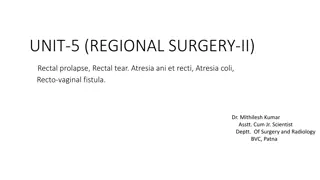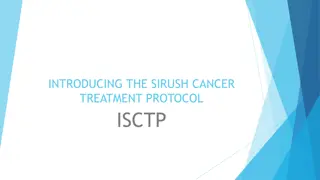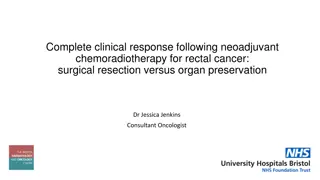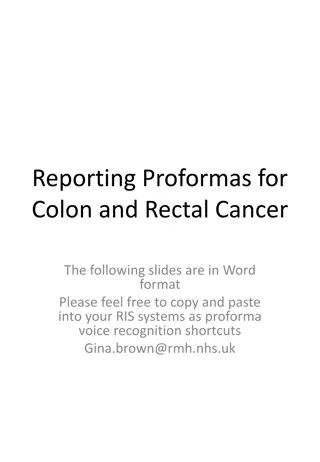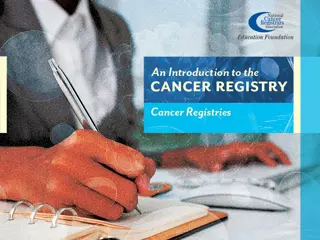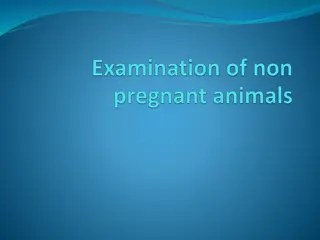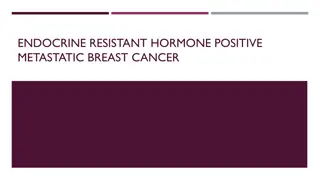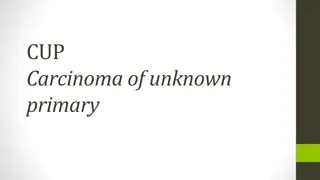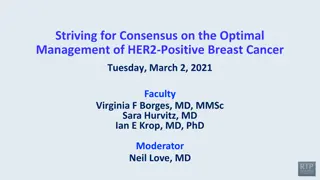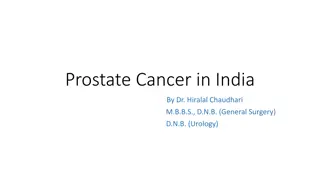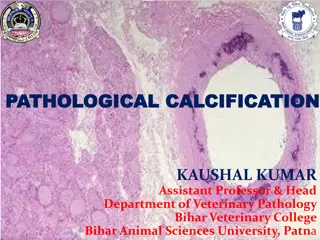Comprehensive Review of Mr. A's Metastatic Rectal Cancer Treatment Journey
Mr. A, a 39-year-old man with metastatic rectal cancer, underwent various treatments including chemotherapy, surgery, and maintenance therapy. Despite some side effects and complications, he showed positive tumor responses and clear margins post-surgery. His treatment involved a combination of Folfiri, Avastin, and other medications over several years, with periodic imaging scans to monitor disease progression. The comprehensive care plan also included interventions for managing symptoms and maintaining quality of life.
Download Presentation

Please find below an Image/Link to download the presentation.
The content on the website is provided AS IS for your information and personal use only. It may not be sold, licensed, or shared on other websites without obtaining consent from the author. Download presentation by click this link. If you encounter any issues during the download, it is possible that the publisher has removed the file from their server.
E N D
Presentation Transcript
Mr A is a 39 yo man who attended for review and maintenance therapy for metastatic rectal cancer
Sep 2010: colonoscopy= rectal carcinoma, CT= liver mets Oct 2010: Nov 2010 some minor SEs (cold feet, loose bowels, fatigue), positive tumour response Apr 2011: moderately differentiated adenocarcinoma. Nil complications. Jun 2011: diarrhoea. Some periph neuro. Recovering well from surg. Aug 2011: infective diarrhoea Sep 2011: Oct 2011: no chemo Sep 2010: attended GP regarding 6/12 PR bleeding; Oct 2010: Completed 5 weeks of RT and PVI 5FU Nov 2010- - Mar 2011: Mar 2011: Commence folfox-6/Avastin, Apr 2011: Combined resection of liver and rectum= Jun 2011: Commenced Folfiri, dose reduced due to Aug 2011: ECOG 1. Chemo delayed 1 week due to Sep 2011: Ileostomy reversal Oct 2011: Postop infection after reversal, ~8weeks
Nov 2011: mets. Nil SEs Jan 2012: some haemorhoids Feb 2012: (unresectable), intense uptake in primary. Nil sig SEs, ECOG 1 Mar imaging. Aug 2012: weekly cetuximab (maintenance) Sep 2012 persisting w/ abx. Nov 2011: Inc CEA, inc liver mets and new lung Jan 2012: dec liver met size, lungs cleared. Nil SEs, Feb 2012: Folfiri/cetuximab. PET= 12 foci in liver Mar- -Jul 2012: Jul 2012: Rash, diarrhoea. Improving on Aug 2012: Finished folfiri. CT clear. Commenced Sep 2012- -Jan 2013: Jan 2013: Nil issues. ECOG 0. Minor rash
Feb 2013: disease, unresectable. Commenced Folfiri- m/Bevacizumab. Minor SEs, ECOG 0-1 Mar Jul 2013: 1. Commenced bevacizumab/capecitabine. Aug2013: acid/avastin) 3 weekly. CT/PET= small residual liver disease. Sep 2013 CEAs. CT stable. Mar 2014 issues. Some mild nausea. Feb 2013: Progression on US/CT. PET= multifocal Mar- -Jun 2013: Jul 2013: Completed 12 cycles. SE: diarrhoea. ECOG Jun 2013: Nil issues. CT stable. Aug2013: Commenced de Gramont (5FU/folinic Sep 2013- - Feb 2014: Feb 2014: Nil SEs (diarrhoea). Unstable Mar 2014: Commenced Folfiri/Bevacizumab. Nil sig
Attended GP w/ ~6/12 hx of painless PR bleed Colonoscopy: rectal carcinoma RT & avastin Commenced chemotherapy Combined anterior resection/liver resection Uncomplicated procedure Dx: Moderately differentiated adenocarcinoma, Stage IV 5/10 liver lesions resected Margins clear, 6 benign regional LN harvested
Current medications: Gastrostop, codeine phosphate. ?Dex (excitability) Phx NKA Hernia as baby Nil other hx FHx Nil relevant hx
Social Mr A lives with his wife and two children (3 and 5). He continues to work at an office job ~4/7. Nil financial issues. Smoking hx: 1-2 packs/week when young adult Alcohol: ~20/week prior to dx, very occasional use now Relatively poor diet/exercise
Initial Dx: Metastatic rectal adenocarcinoma RX (earliest most recent): 1. 6x 5FU + RT 2. 11x Folfox 6m/beva 3. 15x Folfiri m/ beva 4. 10x Folfiri-m/cetux 5. 24x weekly Cetux 6. 12x Folfiri-m/beva 7. 1x Beva/cape 8. 11x De Gramont 9. 12x Folfiri/beva (until Aug 14) Additional medications Hydrocortisone Phenergan Aprepitant (CINV) Palonsteron (CINV) NaCl (hydration)
Incidence: 2010: 14,860 new cases Risk of dx by 85: 1/10 (m), 1/15 (f) Risk of dev second primary in colon: 1%/year Mortality: In 2011, there were 3999 colorectal ca related deaths (second highest after lung cancer) Aetiology: Multifactorial Genetic predisposition (eg familial adenomatous polyposis [FAP], hereditary nonpolyposis crc [Lynch syndrome]) Environmental carcinogens
Colorectal polyps Genetic mutations FAP (defective APC = 100% chance of ca by 55yo), Lynch, kras, braf Family hx First deg relative: more than 2x risk Inflammatory bowel disease UC: risk= 2% at 10yr, 8% at 20yr, 18% at 30yr Cr: 1.5-2x risk Phx other cancers Advanced age Poor diet (high fat, low fibre, high red meat etc) Obesity/sedentary lifestyle Smoking (2.5x risk)/alcohol/enviro carcinogens
Pathophys: Type: Majority of colorectal cancers are adenocarcinomas derived from epithelial cells ~71% arise in the colon, 29% in the rectum Other types: carcinoid tumours (rectum/caecum), GI stromal cell tumours, and lymphomas 2/3 in left colon, 1/3 in right colon. Right-sided more common in women 2-% CRCs are rectal, of which can be felt on PR ~3% CRCs are multicentric 30% -50% have mutated KRAS gene respond to anti-epidermal growth factor receptor [EGFR] antibody therapy 40% to 60% of patients with wild-type KRAS tumors do not respond to this therapy mutated BRAF gene (5% to 10% of tumors) can affect response Spread: Lymphatic Vascular invasion Local invasion Sites Regional LN (40-70%), liver (usually colon), peritoneal cavity, lungs (usually rectal), adrenals, ovaries, bone, brain (rare)
Sx Right sided often asymp; or dull/vague pain, anaemic sx (fatigue, weight loss, weakness) Left sided: change in bowel habit/stool consistency, PR bleed, abdominal bloating or cramping, obstruction Clinical signs Bloating Signs of anaemia Weight loss Abdo mass
Ix Clinical exam/PR FOBT Bloods (FBE, UEC, LFT,CEA) Colonoscopy (+bx) Barium enema CT colonography EUS CT/PET/MRI Ddx IBS IBD Anal fissure Haemorrhoids Diverticular disease
Primary tumour (T) Tx: Primary tumor cannot be assessed T0: No evidence of primary tumor Tis: Carcinoma in situ: intraepithelial or invasion of the lamina propria T1: invasion of submucosa T2: invasion of the muscularis propria T3: invasion through the muscularis propria into pericolorectal tissues T4a:Tumor penetrates to surface of visc peritoneum T4b: tumour directly invades or is adherent to other organs/structures
Regional lymph nodes (N) Nx: Regional lymph nodes cannot be assessed N0: No regional lymph node metastasis N1: Metastasis in 1-3 regional node(s) N1a: Metastasis in 1 regional node N1b: Metastasis in 2-3 regional nodes N1c: Tumour deposits in subserosa, mesentery, or nonperitonealize pericolic or perirectal tissues w/o regional node mets N2: Metastasis in >4 regional nodes N2a: Metastasis in 4-6 regional nodes N2b: Metastasis in >7 regional nodes
Stage IIB: T4a, N0, M0. Dukes B, MAC B2 Stage IIC: T4b, N0, M0. Dukes B, MAC B3 Stage IIIA: T1-2, N1, M0. Dukes C, MAC C1 T1, N2a; M0. Dukes C, MAC C1 Stage IIIB: T3-4a, N1/1c; M0. Dukes C, MAC C2 T2-3, N2a; M0. Dukes C, MAC C1/2 T1-2, N2b; M0. Dukes C, MAC C1 Stage IIIC: T4a, N2a; M0. Dukes C, MAC C2 T3-4a, N2b; M0. Dukes C, MAC C2 T4b, N1-2; M0. Dukes C, MAC C1 Stage IVA: any T, any N, M1a Stage IVB: any T, any N, M1a Distant metastasis (M) Mx: distant metastasis cannot be assessed M0: no distant metastasis M1: distant metastasis present M1a: mets confined to one organ/site M1b: mets in >1 organ/site or the peritoneum Stage grouping Stage 0: Tis, N0, M0 Stage I: T1/2, N0, M0. Dukes A, MAC A/B1 Stage IIA: T3, N0, M0. Dukes B, MAC B2
Dukes Dukes' A: Invasion into but not through the bowel wall(90% 5-y survival) Dukes' B: Invasion through the bowel wall but not involving lymph nodes(70% 5-y survival) Dukes' C: Involvement of lymph nodes (20-30% 5-y survival) Dukes' D: Widespread metastases (<5% 5-y survival MAC Stage A: Limited to mucosa Stage B1: Extending into muscularis propria but not penetrating through it; nodes not involved Stage B2: Penetrating through muscularis propria; nodes not involved Stage C1: Extending into muscularis propria but not penetrating through it. Nodes involved Stage C2: Penetrating through muscularis propria. Nodes involved Stage D: Distant metastatic spread
GX: Grade cannot be assessed G1: Well-differentiated (low grade) G2: Moderately differentiated (intermediate grade) G3: Poorly differentiated (high grade) G4: Undifferentiated (high grade)
Prognosis: 5-year survival rates by tumour stage: Stage I, 93% to 97% Stage II, 72% to 85% Stage III, 44% to 83% (depending on nodal involvement Stage IV, <8% Factors Stage Clinical presentation (obstruction/perf) Tumor location (rectal, transverse, descending worse) Chromosome 18 (allelic loss) Histologic grade (well-differentiated>poorly diff) Tumour characteristics/markers
Surgery Open, laparoscopic, trans-anal Extent of the colectomy depends on tumour site/size Resection and examination of a minimum of 12 nodes is necessary for accurate staging ?Concurrent resection of mets Chemotherapy Radiotherapy (rx or pall) Other Floxuridine for flushing hepatic arteries (supply mets; veins supply hepatocytes)
Metastatic colorectal cancer: FOLFIRI (Fluorouracil Repeated every 2 weeks continuously until disease progression or unacceptable toxicity FOLFIRI (Fluorouracil Leucovorin Leucovorin Irinotecan Irinotecan) with ) with Bevacizumab Bevacizumab SE: Caution: neutropaenic sepsis (admit) Immediate (onset hours to days) Cardiotoxicity a/w Fluorouracil and Capecitabine Diarrhoea & Cholinergic syndrome (a/w Irinotecan) N/V Early (onset days to weeks) Anaemia/neutropenia/thrombo cytopenia (delay) Oral mucositis Hand-foot syndrome Fatigue Diarrhoea Hyperlacrimation Actinic keratoses flare HTN Proteinuria Photosensitivity Gastric perforation Thromboembolism Expstaxis Late (onset weeks to months) Alopecia Nail changes Hyperpigmentation
OS (18.2 vs. 16.3) PFS (8.9 vs. 6.5) evident benefits of additional BEV in OS and PFS can be identified in all subgroups, except for the CTX containing capecitabine in OS
EviQ Best Practice Medscape Manual of Clinical Oncology, seventh ed. Weitz J, Koch M, Debus J, et al. Colorectal cancer. Lancet 2005;365:153. Chao Lv, Shuodong Wu, Duo Zheng, Yuli Wu, Dianbo Yao, and Xiaopeng Yu. Cancer Biotherapy & Radiopharmaceuticals. September 2013, 28(7): 501-509. doi:10.1089/cbr.2012.1458. Meyerhardt JA, Li L, Sanoff HK, et al. Effectiveness of bevacizumab with first-line combination chemotherapy for Medicare patients with stage IV colorectal cancer. J Clin Oncol 2012;30:608. Hochster HS, Hart LL, Ramanathan RK, et al. Safety and efficacy of oxaliplatin and fluoropyrimidine regimens with or without bevacizumab as first-line treatment of metastatic colorectal cancer: Results of the TREE Study. J Clin Oncol 2008;26:3523. Thirion P, Michiels S, Pignon JP, et al. Modulation of fluorouracil by leucovorin in patients with advanced colorectal cancer: An updated meta-analysis. J Clin Oncol 2004;22:3766. Moertel CG. Chemotherapy for colorectal cancer. N Engl J Med 1994;330:1136. Van Cutsem E, Twelves C, Cassidy J, et al. Oral capecitabine compared with intravenous fluorouracil plus leucovorin in patients with metastatic colorectal cancer: Results of a large phase III study. J Clin Oncol 2001;19:4097. Van Cutsem E, Hoff PM, Harper P, et al. Oral capecitabine vs intravenous 5-fluorouracil and leucovorin: Integrated efficacy data and novel analyses from two large, randomised, phase III trials. Br J Cancer 2004;90:1190. 1. 2. 3. 4. 5. 6. 7. 8.





